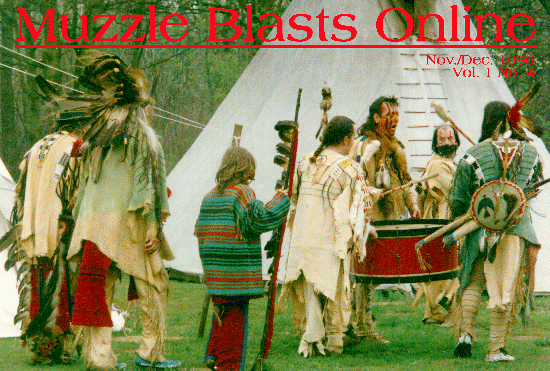|
Muzzle Blasts Online |
|
...for the muzzleloading enthusiast |
|
The muzzleblasts.com domain, subdomains, content, etc., are neither affiliated with the NMLRA nor its paper magazine Muzzle Blasts |
|
Muzzle Blasts Online |

|
|
|
|
|
|
Book Review
By Robert G. Swartz
Illustrated by Karen Pannebaker and Ben Stahl Turbotville (Warrior Run), PA
Warrior Run-Fort Freeland Heritage Society
Order from R.G. Swartz and Associates
P.O. Box 7568
Lancaster, PA 17604-7568 1996. Paperbound. 114 Pp. ISBN Number 0-9653989-0-0. No price given.
Swartz relates that this was no isolated skirmish but part of a well orchestrated plan. The patriots wished to destroy the Iroquois Indians' ability to wage war and the British plan was to bring the horrors of war home to the Patriots and to skirmish for food and supplies. Pannebaker's maps help the reader understand both the British and their Iroquoian ally advance and the actual battle at Fort Freeland. Indeed, this Northeastern part of Pennsylvania as a constant blood bath for both sides during the American Revolution!
Patriot Robert Covenhaven actually observed the advance of the Iroquoian Indians, but it is not for certain if he realized that their British allies were with them. The British commander, Captain John McDonell, leading a contingent of battle-tempered Butler's Rangers, realized that both his men and Indian allies were starving. They simply needed to skirmish for food or die. At the same time General Washington's plan was to destroy as much of the Iroquoian corn fields as possible to try to neutralize their fighting abilities. And he assigned a force under General John Sullivan of New Hampshire to this task. As Swartz relates, the jury will be forever out why Sullivan and his forces did not come to the aid of those in the rural areas. Such questions of this type will probably continue to be food for thought for both military and frontier historians for some time to come. Within this backdrop, however, it was imperative that Patriot Robert Covenhoven spread the alarm. But the jury will be forever out as to whether the alarm had ever reached the high point of ground (which Swartz relates would be the site of the future Warrior Run High School), that held the newly constructed Fort Freeland. Thanks to the author, readers have appendices of listings for both the Fort Freeland defenders and the relief expedition under Captains Boone and Kemplin.
Swartz shows that Colonel Samuel Hunter, headquartered at Fort Augusta, was engaged in some form of general withdraw of forces and noncombatants from the general area, especially posts in the upper Wyoming Valley. But based on the demands and lifestyle of the agrarian community, it would be naturally difficult to get those, tied closely to the demands of both the land and livestock, it would have been difficult to get such people to leave under any circumstances.
Credit should go out to both McDonell and Cornplanter, the Iroquoian leader, that their combined force went undetected before they arrived on high ground above Fort Freeland the evening of the 27th of July of 1779. It was a simple matter to await dawn of the next day. Swartz also wrote ``Fields of Honor:The Battle of Fort Freeland, July 28, 1779'' to commemorate the Warrior Run-Fort Freeland Heritage Society and Tiadaghton Chapter, SAR dedication of a beautiful monument on this same site on the 28th of July of 1996.
When dawn arrived, these battle-hardened Butler's Rangers and their Iroquoian Indian allies, went into action. Taking aim at the loopholes, the contingents began its work. By 9:30 in the morning McDonell approached the fort under a flag of truce. There were only five of the twenty-six soldiers left along with a number of noncombatants. McDonell gave the defenders exactly one half hour to make a decision to either surrender under promise of safety to all inside the fort or else he would order his troops and Iroquoian allies to kill everyone in an all out attack. Swartz supplies dramatic, first person scenario as he describes one's innermost thoughts concerning going out of the fort's gates into a word of uncertainty at 10:00 that morning. But the battle was not over. Reinforcements were on their way in the form of a contingent of militia from Boons Mill under the command of Captains Boone and Kemplin. It remains obvious that the relief force had underestimated the ability of the attackers of that they were foolhardy at best. But that afternoon, this force arrived on the scene. Within a short period of time half of this force as well were out of action.
McDonell kept his word by setting the noncombatants at liberty and protecting his male prisoners, even when it remains obvious that his Iroquoian allies would have urgently desired that the prisoners run the gauntlet to either replace a killed family member and then either kill or sell the captives to their British allies. And the march began to take the soldiers—prisoners of war to Fort Niagara. It would be several years before any of these prisoners would ever see home again.
Swartz relates that it remains quite possible that the Fort Freeland tragedy might have been avoided if: (1) Covenhaven's warnings had been received at Fort Freeland; or (2) if authorities had correctly acted when they heard such warnings. And the jury will be forever out concerning the failure of General John Sullivan to come to the aid of such people under attack in the rural areas. ``Fields of Honor: The Battle of Fort Freeland, July 28, 1779'' indeed would be an ideal book to help those come to appreciate one's innermost thoughts in the stressful battlefield conditions or any person interested in frontier history.